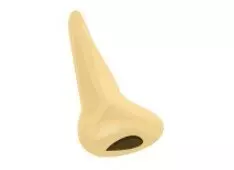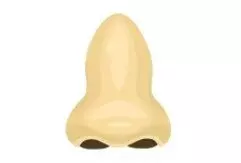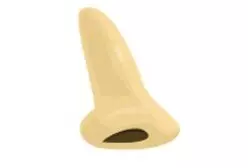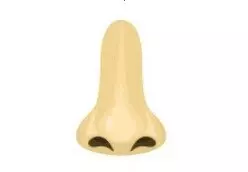Ethnic Rhinoplasty is the art of making a natural looking nose that has characteristics related to the race (European, African, Middle Eastern, Latin American, Asian and Hispanic) to which people belong. With various surgical techniques, the cosmetic shape desired by the patient is performed by correcting the deformities in the nose. As a matter of fact, since rhinoplasty is a personal procedure, each rhinoplasty is planned according to the specific facial features and general nose structure of the patient. However, the different ethnic structures of individuals highlight certain characteristic nose types. Considering the nose structure of Asians, it can be said that the nose structure is generally smaller and humpless compare to other ethnic noses. Depending on this situation, the scope of the rhinoplasty operation will vary.
Common Nose Characteristics by Ethnicity and the Applied Method
Common features are seen in nose types originating from different ethnicities. Surgical techniques for noses with this feature also differ. Ethnic rhinoplasty is significantly different from conventional rhinoplasty for people of Caucasian descent. Nasal structure that requires cartilage and bone removal is seen in Caucasians, but ethnic rhinoplasty is performed in people of African-American origin or Asians, with nose augmentation and cartilage addition method. Most importantly, ethnic rhinoplasty aims to help patients improve their facial appearance without losing their unique facial features.
Common Nose Characteristics and Generally Applied Method
Nose Augmentation: Augmentation is common in all ethnicities. Subtle changes are made to the angles and the definition of certain areas to balance the proportionality of the nose. It is mostly done by rearranging the cartilage. In some cases, cartilage (graft) may need to be taken from the rib due to cartilage deficiency. Examples;
- Creating clearer or softer lines where the nostrils meet the bridge of the nose to create the illusion of a narrower tip.
- Pointing the tip of the nose up (rotation) or down (rotation) to increase or shorten its distance from the lip. This changes how close the nose appears to the face and can offset a prominent bridge.
Revision rhinoplasty: Some patients may benefit from revision surgery to correct previous unsuccessful surgeries. Revisional ethnic rhinoplasty requires expertise. Any surgery can result in scar tissue, which increases the complexity of rhinoplasty approximately tenfold.
Nose Reduction: Reducing the physical size of the nose by removing cartilage and bone from the infrastructure. The goal is to bring the previously protruding features closer to the rest of the face. This is more common in Middle Eastern patients.
Projection: Increasing the physical size of the nose by grafting cartilage from the patient’s septum and/or ribs to the underlying structure in the flatter areas of the nose. Projection allows these areas of the nose to stick further from the face, resulting in a narrower, more elegant and more balanced look. This is more common in African-American, Asian, Pacific Islander, Native American, and Hispanic patients.
Ethnic Rhinoplasty Types
European Rhinoplasty
From generation to generation, Europeans have facial phenotypes and nasal characteristics belonging to their ethno-cultural, hybrid and geographical features. While the nose structure of European origin varies, they mostly have thin skin, an upturned nose tip, a thin and prominent nose structure.
The most popular requests from European rhinoplasty patients are:
- Reducing the size of the nose – Some patients want the facial features to be more prominent by reducing the size of the nose.
- Improve the bridge of the nose – Some patients may want a flatter profile, while others may want a more curved nose structure.
- Obtaining a natural appearance– It is important to preserve the nose features of European origin after rhinoplasty.
- Achieving a celebrity look – Some patients want to have the nose of an artist they love, and request a famous look without losing the naturalness of the nose structure.
- Breathing problem – The person who will have a nose surgery after the operation wants to get a natural appearance, as well as to eliminate the breathing problem by repairing the structural problems in the nose.
Middle East Rhinoplasty
While the nose structure varies in most Arab countries, the nose structure is similar in most people of Middle Eastern ethnicity. Middle Eastern individuals have thicker skin. The tip of the nose is drooping, wide and less prominent. There is usually a hump on the bridge of the nose. The base of the nose may be wide. In addition to the thickness of the skin, the cartilage of many female and male patients with middle eastern nose structure is relatively weak. Every effort is made to strengthen the cartilage.
Some of the most popular goals for Middle Eastern rhinoplasty patients include:
- Improving the bridge of the nose – Some people want to maintain the straight profile commonly associated with the Middle Eastern nose, while others want to achieve a more curved or “scooped” nose dorsum commonly associated with Northern and Western European noses.
- Fixing a droopy nose tip – Many patients want to raise the position of the tip of the nose to improve the angle of the nose.
- Stabilizing a hyperdynamic nasal tip – Some people try to prevent the tip of the nose from moving downward when smiling or talking.
- Reducing the size of the nose – Some patients simply want to reduce the size of their nose so it fits better with the rest of their facial features.
- Improving nasal breathing – A few people want to improve their nasal breathing ability by repairing a crooked septum and/or other structural issues.
African-American Rhinoplasty
African American rhinoplasty refers to nose surgery specifically designed to improve the appearance and/or function of the nose while respecting the typical characteristics of individuals of African descent. The African-American nose structure features thicker ethnic skin, a wider tip, a wider lower nasal bridge, and enlarged nostrils.
Some of the most common goals and aesthetic preferences among black rhinoplasty patients are:
- Adjusting the bridge of the nose – Some people want to narrow the bridge of the nose to achieve better nose-face balance.
- Nose elevation – Many patients want to raise the bridge of the nose to add height to a “flattened” nose.
- Correction of the tip of the nose – Few people want to improve the definition of the tip of the nose for better projection.
- Narrowing the nostrils – Some patients try to reduce the base and width of the nostrils to reduce a “bright” appearance.
- Resolving nasal breathing problems – Some individuals seek to correct a deviated septum and/or other structural problems to improve nasal breathing.
Hispanic Rhinoplasty
Hispanic rhinoplasty; It is a term that encompasses nose surgery for individuals of many different Hispanic and Latino descent, including people from or with ancestry from Spain, Mexico, Central America, South America, and various Caribbean island nations. Many Latin patients complain of the flatness or arch of the nasal dorsum, and this type of nasal dorsum causes the nose to appear much wider than it is. In Latin patients, the nostrils and nasal tip may be wide, and the nasal skin may be thick. Recession of the nasal wings is very common in people with a typical Latino nose.
While the exact reasons for continuing treatment are entirely unique to each person, some of the most common cosmetic and functional aspirations shared by most Latino/Spanish rhinoplasty patients include:
- Narrowing various parts of the nose – Some people want to reduce the width and size of the nose tips, nostrils, and bridge of the nose to more harmoniously fit their other features and overall facial aesthetics.
- Dorsal hump reduction – A few patients attempt to straighten their dorsal hump to achieve a straight nasal bridge or a curved nasal bridge.
- Defining the tip of the nose – Many people desire to improve the definition and contour of the nose tip for improved projection and/or a more proportional appearance.
- Improved nasal breathing – Some patients wish to correct a crooked septum, weakened nostrils, and/or other structural nasal problems to improve their nasal breathing ability.
What is The “Implant-Free Technique” for Rhinoplasty? Can The Implant-Free Technique be Used in Hispanic Patients?
Asian Rhinoplasty
Asian rhinoplasty is a term that encompasses nose surgery for individuals who wish to improve the appearance and/or function of the nose while respecting the unique characteristics of individuals from or native to China, Japan, South Korea, and various other Asian countries.
Some general cosmetic and functional preferences shared by many patients seeking Asian rhinoplasty include:
- A high and/or narrowed nose bridge – Several men and women prefer raising and/or narrowing the bridge of the nose to give height and definition to a “flattened” nose as well as improve nasal-facial balance.
- A more defined nose – Some people aim to widen and/or lengthen their nose to make it more proportional to the general shape of their face.
- A refined nose tip – Many people want to improve the definition of the nose tip to improve the projection of the nose.
- Narrower nostrils – Some patients want to reduce the width and base of their nostrils to reduce the appearance of “flare”.
- Improved nasal breathing – Some people try to repair a crooked septum and/or other structural problems to breathe better through the nose
Do I Need An Implant in Asian Rhinoplasty?
Do I Need Graft Tissue for Asian Rhinoplasty?
Traditional rhinoplasty techniques are often insufficient to define the bridge of the nose. Graft material options include your own cartilage (septal cartilage or rib cartilage) or irradiated and purified cadaveric rib cartilage. In the same way, the same graft is used to clarify the tip of the nose and raise the ridge of the nose. Thus, a more prominent and aesthetic result is obtained.
Ethnic Rhinoplasty Surgery Technique
As mentioned earlier, different races have certain characteristic nose and facial structures. In ethnic rhinoplasty, genetic characteristics are taken into consideration and the ethnic characteristics of the person are tried to be preserved as much as possible. The aim is to reshape the patient’s nose and repair any structural defects. What is important in ethnic rhinoplasty is not the elimination of the characteristic features from the ethnic group to which the person belongs; is to make a person a beautiful member of the race to which he belongs. In ethnic rhinoplasty, as well as in all nose surgeries, a planning is made to take care of the natural rhinoplasty. Therefore, the golden ratio is observed when performing ethnic rhinoplasty. In other words, a road map is drawn by considering all the elements of the person’s face and patient wishes. Within the scope of ethnic rhinoplasty, cartilage reduction or augmentation practices are applied to a certain extent in line with the wishes of the patient. In this way, the nose is reshaped and modeled. Nasal lines can be made more prominent with cartilage grafts added according to the created surgery plan. The bridge of the nose can be enlarged with cartilage grafts, the nose can be elongated or the tip of the nose can be clarified. This includes the process of narrowing the base of the nose. At this point, the important thing is the surgery plan that the doctor creates by taking into account the results obtained after the examination and your demands.
The main techniques and technologies used in rhinoplasty operations are as follows;
- Closed Rhinoplasty
- Open Rhinoplasty
- Micromotor Technology Rhinoplasty
- Microrhinoplasty
- Piezo Ultrasonic Technology Rhinoplasty
- Dorsum Preservation Surgery
The rhinoplasty technique and technology used in ethnic rhinoplasty is also important. As TAS Aesthetic Surgery Center, we use closed technique rhinoplasty and micro-motor technology, which is superior to other techniques in ethnic nose surgeries. You can click on the link below for detailed information on the subject.
In the light of this information, the most typical concerns of ethnic rhinoplasty patients and the most appropriate method they want are shown below. Any plastic surgeon should also offer you options based on your unique characteristics and goals.
| Ethnicity | Thick Skin | Thin Skin | Bulbous Tip | Flat or Wide Nose Tip | Wide Nose Bridge | Narrow Nose Bridge | Nose Reduction | Decreasing Projection | Increasing Projection |
| European | x | x | x | x | |||||
| African-American | x | x | x | x | x | ||||
| Asian | x | x | x | x | |||||
| Hispanic | x | x | x | x | x | x | |||
| Middle East | x | x | x | x | x |
Factors Affecting Ethnic Rhinoplasty Prices and Attained Result
There is no clear information about ethnic rhinoplasty prices before the examination. As a matter of fact, the full price comes out as a result of the examination. The main reason for this is that there are many factors that affect ethnic rhinoplasty prices. Variables such as the success and experience of the aesthetic doctor in ethnic rhinoplasty, the hospital stay, and the number of days in the hospital can be counted among the factors in question. The ultimate goal in ethnic rhinoplasty; It is to shape the nose structure in accordance with the ethnic origin of the person and give it a natural appearance. But to give an idea to our readers, we can say ethnic rhinoplasty prices vary between 6.000 – 30.000 Euro.
Frequently Asked Questions
Who Is Ethnic Rhinoplasty Suitable For?
What Are the Risks?
Many of these risks can be avoided with technical expertise and skill. Revision rates for rhinoplasty are around 8% in the World. Since smoking delays the healing process, it is recommended that patients quit smoking before surgery.
Will There be Any Scars After Ethnic Rhinoplasty?
Is Ethnic Rhinoplasty a Difficult Operation?
How Does Ethnic Rhinoplasty Affect The Sense Of Smell?
What are the Points to Consider in Nose Care After Rhinoplasty?
- The patient should rest with head area up position.
- The nose area should be protected from all kinds of traumatic events.
- Glasses should not be used during the first 2 months.
- It should be protected from sun rays.
You can access detailed information about the issues to be considered before and after rhinoplasty through the relevant links.
We have come to the end of our blog post about ethnic rhinoplasty. We have given you detailed information so that you do not have any doubts about the process. For your questions, you can contact us from the comment field below or WhatsApp.






